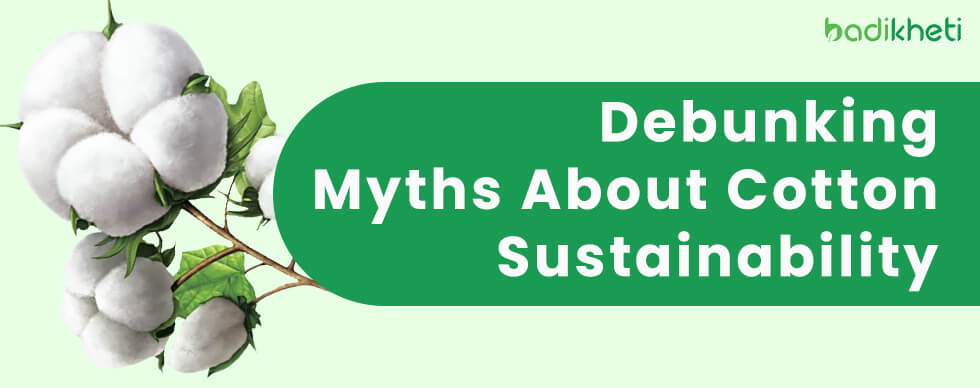
The cotton industry is often misunderstood due to outdated myths about its environmental impact. However, modern farming techniques have greatly reduced the energy, water, and chemical usage of cotton production, making it a more sustainable crop than it was in the past.
Let’s dispel some of the most common myths related to cotton’s sustainability and show some reality.
Reality: The cotton industry has reduced its energy use by more than 50% over the last four decades. With the implementation of conservation tillage, cotton farmers have been able to reduce the number of tillage passes and the use of tractors, which leads to a decrease in fuel consumption. This, in turn, results in a reduction of carbon emissions and the reduction of costs for farmers.
Reality: Cotton is actually a drought-resistant crop and only accounts for 3% of agricultural water usage worldwide. Cotton farmers have implemented measures to improve water efficiency, with most cotton now surviving on rainfall alone. Irrigation water use in cotton farming has decreased by almost 80% on a unit of production per acre basis. In addition, farmers use precision irrigation systems that only water the plants that need it, which reduces water wastage. This not only conserves water resources but also increases the yield per acre.
Reality: Many cotton farmers today use integrated pest management strategies, which rely on natural predators, and only use pesticides when it is absolutely necessary. This not only reduces the use of pesticides but also reduces costs for farmers. Moreover, due to online portals like BadiKheti, farmers now have access to the best types of fertilizers for cotton farming in India. In addition, farmers are now using precision agriculture techniques that allow them to apply the right amount of fertilizer at the right time, which reduces the use of fertilizers and increases the yield per acre.
Reality: Cotton only occupies 3% of the world’s agricultural land, and cotton growers have reduced land use by nearly half in recent decades. Modern farming technology has allowed cotton farmers to produce more cotton per acre, resulting in less land used for cotton cultivation. Conservation tillage, which is the practice of leaving last year’s crop residue in the field, is used to reduce soil loss, increase water holding capacity, and minimize runoff. This not only conserves land resources but also increases the yield per acre.
Reality: This is one of the most common cotton myths. Cotton farming can lead to soil erosion and depletion when not managed sustainably. Sustainable cotton production can improve soil health and reduce greenhouse gas emissions. By using conservation tillage, farmers can reduce soil erosion, increase soil organic matter, and improve soil structure. This not only conserves soil resources but also increases the yield per acre.
Reality: The price of cotton can fluctuate due to various factors such as government regulation, stockpiling, and subsidies for farmers. This, along with the financialization of cotton, can create an uncertain market for farmers, creating problems and making cotton less attractive to grow. However, by using sustainable cotton farming techniques, farmers can reduce costs and increase yields per acre, which can make cotton farming more attractive to farmers.
BadiKheti is the best place to buy cotton seeds online in India at a cost-effective rate. We are committed to providing high-quality, sustainable cotton seeds. We also provide detailed information about each seed variety, including its best uses and ideal growing conditions, and other factors to consider while buying cotton seeds. This helps farmers make informed decisions about which seeds to buy. Furthermore, Our easy-to-use online platform and prompt delivery service make it easy and convenient for farmers to purchase the cotton seeds they need, and our competitive prices make it affordable.
Introduction Chilli fondly known as "Mirchi" in Hindi holds great cultural and historical significance in India. It is not merely a culinary delight but an integral part of our traditions with significant links to agriculture and daily life. India takes great pride in being one of the leading producers and consumers of chillies globally, with various regions contributing to this spicy farming. This article aims to analyze the primary states involved in chilli cultivation within India, exploring their unique functions within the flourishing chilli industry....
The Indian economy is based on agriculture, and the farmer's livelihood relies on the rain in monsoon season. But it isn’t certain, so depending entirely on it may affect soil management and agricultural yields. Crops need a proper quantity of water for their development. The only means our farmers can keep storing and using water properly is via irrigation. In this blog, we will understand the irrigation methods for excellent water management for Indian farmers. Undoubtedly, the world’s agricultural area has increased in the past,...
Spices constitute an essential element of Indian gastronomy, imparting richness, and piquancy to an array of recipes. Among them, a distinct position is held by chili peppers, which however face consistent threats from various diseases that can cause severe damage to crops. Disease-resistant chili seeds have lately emerged as a revolutionary alternative to safeguard chilli farming in India. This write-up explores the prospective benefits of these types of chilli seeds and their significant impact on the future of Indian spice agriculture. The predicament of diseases...